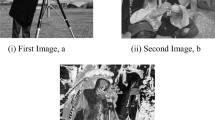Abstract
Most traditional key agreement protocols are based on data exchange. In this paper, a novel key agreement protocol based on image exchange is proposed. In this protocol, the communication entities who want to establish a session key are pre-assigned a secret image by the registration center (RC) initially. In real-time communication, using this image as the source image, along with another image of her/his choosing as the target image, the entity creates a morphed image and transmits it to the other communication entity. At the receiver side, the entity de-morphs the received image using the same source image and recovers the target image. However, the recovered image is not completely the same as the original image because some pixels have been lost during the morphing process. Therefore, the relationship between the original image and the morphed image needs to be analyzed and the lost pixels are located accurately. By removing the lost pixels from the self-generated original image and the recovered image of the other entity, both communication entities can obtain the same information that can be used as the secret session key. This approach using the exchanged morphed image for establishing secret session key can conceal the purpose of the key distribution and therefore enhances its security. In addition, the exchange of the image between two entities provides intuitive information for communication entities.







Similar content being viewed by others
References
Ali A, Irum S, Kausar F, Khan FA (2013) A cluster-based key agreement scheme using keyed hashing for body area networks. Multimed Tools Appl 66(2):201–214
Areeyapinan J, Kanongchaiyos P (2012) Face morphing using critical point filters. In: Proc. JCSSE, Thailand:283–288
Beier T, Neely S (1992) Feature-based image metamorphosis. In: Proc. SIGGRAPH, USA:35–42
Bertalmio M, Sapiro G, Caselles V, Ballester C (2000) Image inpainting. In: Proc. SIGGRAPH, USA:417–424
Biham E, Chen R (2004) Near-collisions of SHA-0, advances in cryptology—CRYPTO 2004. Lect Notes Comput Sci 3152:290–305
Boneh D, Franklin M (2001) Identity-based encryption from the Weil pairing. In: Proc. CRYPTO, USA:213–229
Diffie W, Hellman M (1976) New direction in cryptography. IEEE Trans Inf Theory 22(6):644–654
Harn L, Lin CL (2010) Authenticated group key transfer protocol based on secret sharing. IEEE Trans Comput 59(6):842–846
Jarecki S, Kim J, Tsudik G (2011) Flexible robust group key agreement. IEEE Trans Parallel Distrib Syst 22(5):879–886
Joux A (2004) A one round protocol for tripartite Diffie-Hellman. J Cryptol 17:263–276
Lai LF, Liang YB, Poor HV (2012) A unified framework for key agreement over wireless fading channels. IEEE Trans Inf Forensic Secur 7(2):480–490
Law L, Menezes A, Qu M, Solinas J, Vanstone S (2003) An efficient protocol for authenticated key agreement. Des Codes Crypt 28(2):119–134
Mao Q, Bharanitharan K, Chang CC (2013) Edge directed automatic control point selection algorithm for image morphing. IETE Tech Rev 30(4):336–343
McCullagh N, Barreto PSLM (2005) A new two-party identity-based authenticated key agreement. In: Proc. CT-RSA, USA:262–274
Nakamura H, Zhao QF (2008) Information hiding based on image morphing. In: Proc. AINA, Japan:1585–1590
Renna F, Bloch MR, Laurenti N (2013) Semi-blind key-agreement over MIMO fading channels. IEEE Trans Commun 61(2):620–627
Sakai R, Kasahara M (2003) ID based cryptosystems with pairing on elliptic curve. In: Proc. SCIS, Japan:1–6
Salimi S, Salmasizadeh M, Aref MR, Golic JD (2011) Key agreement over multiple access channel. IEEE Trans Inf Forensic Secur 6(3):775–790
Shamir A (1984) Identity-based cryptosystems and signature schemes. In: Proc. CRYPTO, USA:47–53
Wang S, Cao Z, Choo KR, Wang L (2009) An improved identity-based key agreement protocol and its security proof, Inform. Sciences 179(3):307–318
Wolberg G (1989) Skeleton-based image warping. Vis Comput 5(1–2):95–108
Zhang YY, Li XZ, Yang JC, Liu YN, Xiong NX, Vasilakos AV (2013) A real-time dynamic key management for hierarchical wireless multimedia sensor network. Multimed Tools Appl 67(1):97–117
Zhao QF, Akatsuka M, Hsieh CH (2012) Generating facial images for steganography based on IGA and image morphing. In: Proc. SMC, Korea:364–369
Zhao QF, Hsieh CH (2011) Card user authentication based on generalized image morphing. In: Proc. iCAST. China:117–122
Zhao ZF, Luo H, Lu ZM, Pan JS (2011) Reversible data hiding based on multilevel histogram modification and sequential recovery. AEU Int J Electron Commun 65(10):814–826
Zhu L, Yang Y, Haker S, Tannenbaum A (2007) An image morphing technique based on optimal mass preserve mapping. IEEE Trans Image Process 16(6):1481–1495
Acknowledgments
We offer our thanks to Yen-Chang Chen, Xu Zhuang, and Wei-Yi Chen, who are students in the Multimedia and Secure Networking Laboratory, Feng Chia University, Taiwan, for the photographs they provided for our use in this research. The facial images used in Section 6 were provided by the ‘The ORL Database of Faces,’ AT&T Laboratories, Cambridge.
Author information
Authors and Affiliations
Corresponding author
Appendix: Bilinear interpolation
Appendix: Bilinear interpolation
Assume that there are four points in a two-dimensional plane, i.e., z 1(x 1,y 1), z 2(x 2,y 2), z 3(x 3,y 3), and z 4(x 4,y 4), where z i (x i ,y i ) means that the value of point (x i ,y i ) is z i (i = 1, 2, 3, 4). Without loss of generality, we assume that x 1 < x 2 < x 3 < x 4 and y 4 < y 1 < y 2 < y 3, as shown in Fig. 8. Then, for any point with position of (x,y), its bilinear interpolation value z can be achieved by the interpolating function, z(x,y) = BI(z 1(x 1,y 1), z 2(x 2,y 2), z 3(x 3,y 3), z 4(x 4,y 4), x, y), which is:
where z d , z u , y d , and y u are intermediate variables. According to the similarity theorem of triangle, they can be computed as follows:
Rights and permissions
About this article
Cite this article
Mao, Q., Chang, CC., Harn, L. et al. An image-based key agreement protocol using the morphing technique. Multimed Tools Appl 74, 3207–3229 (2015). https://doi.org/10.1007/s11042-013-1780-6
Published:
Issue Date:
DOI: https://doi.org/10.1007/s11042-013-1780-6





